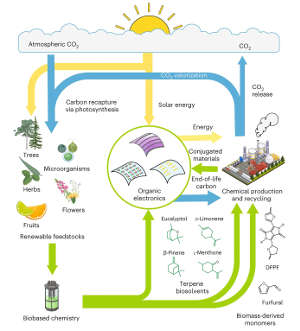Understanding longevity: From gene sequences to social inequity
03 April 2025
Published online 24 December 2022
Bio-based solvents could replace toxic and polluting materials currently used in the organic electronics.

D Corzo et al. Nature Energy
Enlarge image
Solvents are used during the manufacture of organic electronic components to facilitate the chemical coupling reactions involved, also in vital purification steps, and to control the formation of optimal structures.
Organic technologies may release less carbon dioxide than alternatives, but they also require huge amounts of halogenated solvents, which are hazardous to the environment and humans.
“Developing green and sustainable alternative solvents would be a huge step towards implementing such technologies on commercial scales,” says Derya Baran of King Abdullah University of Science and Technology (KAUST). Baran’s group have developed suitable solvents derived from terpenes: a category of organic chemicals widely available from plants, algae and other organisms.
They used their family of terpene solvents for organic printing, to make photovoltaic devices suitable for solar cells, light-emitting diodes and field-effect transistors
”This is an important advance to address the use of toxic and non-sustainable halogenated solvents in printed electronics,” says organic electronics expert, Ludvig Edman of Umeå University in Sweden, who was not involved in the research. “The authors have put a tremendous amount of work into this study, and to demonstrate a similar device performance from bio-based sustainable solvents as halogenated solvents is significant.”
Baran says that exploring the solvents’ potential proved captivating. “Day by day we just did the experiments for fun. The best part was putting the devices into real-world situations and seeing them survive in very harsh conditions,” she says. She expects that many others in the organic electronics field will find the results interesting because, at present, they tend to use the existing solvents without much thought, simply because they provide good performance.
“Now they can go to our solvent library and discover new solvents, which may perhaps outperform current ones with less environmental impact,” she concludes.
Baran says that making photoactive components of devices from low or negative carbon resources with less complex chemical methods is a target for future research. She also suggests that making bio-degradable active components would help build true ‘circular economy’ sustainability into the field.
doi:10.1038/nmiddleeast.2022.82
Corzo, D. et al. High-performing organic electronics using terpene green solvents from renewable feedstocks. Nat. Energy https://doi.org/10.1038/s41560-022-01167-7 (2022).
Stay connected: